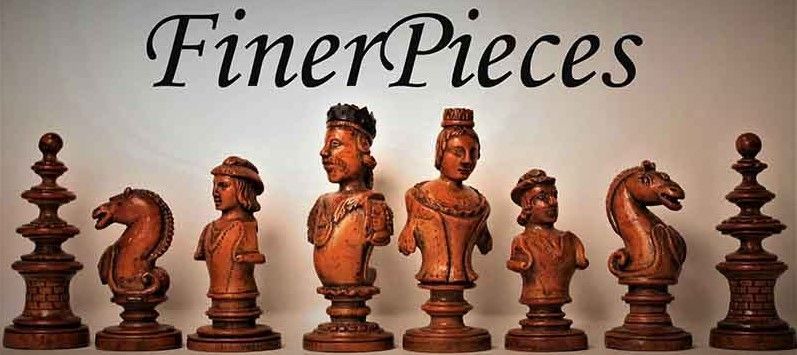French Faience Chess Set, 1900-1950
The chessmen shown here are faience chessmen made in Rouen in the first half of the 20th century. The king size is 9.85 cm. One side is predominantly blue and white while the other is predominantly brown and white. All pieces have red felts on the underside. The set came together with an accompanying faience chessboard tray made in the same style and signed with “MD”. While faience products with a similar sign can be traced back to the 19th and potentially even 18th century, the set shown here is very likely of younger age. Both, the pieces and the tray board are richly decorated with arabesque ornaments and a recurring fleur-de-lys motif.
The term “faience” goes back to the Italian masters of Faenza, a small Italian town, who produced magnificent ceramic tiles depicting historical scenes, arabesque motifs, emblems and coats of arms in the Italian style prevalent during the Renaissance. In 1644 Anne of Austria granted a monopoly to Nicolas Poirel in Rouen. In 1656, Edme Poterat, a master previously working for the Poirel workshop, established his own factory and bought the royal privilege from Poirel’s son in 1674. After Poterat’s death in 1687, his son Michel continued the business until his own death in 1712, after which the factory passed into his wife’s family Leboullenger, where it remained until 1770, then succeeded by Charles Le Coq de Villeray, François-René Dionis, Jean-Baptiste de La Houssiette, and finally Mouchard as its last owner, who operated the factory until 1795. After the age of Enlightenment brought with it an increasing popularity for the game of chess, the Poterat faience manufacture created a chess set in the Regency style decorated in the taste of Rouen around the years 1780. Of these original late 18th century faience chessmen of Rouen very few specimens remain today. As such they are among the most valuable and sought after chess sets. Very few factories continued to stay in business in the 19th century, such as La Méttairie, or Amédée Lambert, but they turned to a more utilitarian production. Only few chess sets were still produced at this time. From the late 19th to the middle of the 20th century, numerous French factories reproduced the decorations of Rouen during the 19th century. They have also revived the original Rouen faience chess sets, although even these reproductions were limited to a few copies, so that even these slightly younger copies have become rare and extremely collectible.















